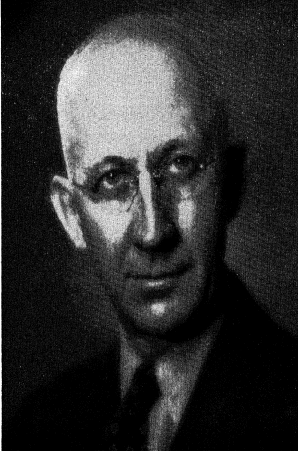Homer Burton Adkins facts for kids
Quick facts for kids
Homer Burton Adkins
|
|
|---|---|

Homer Burton Adkins
|
|
| Born | January 16, 1892 |
| Died | August 10, 1949 (aged 57) |
| Nationality | American |
| Alma mater | Denison University Ohio State University (M.S., 1916) (Ph.D., 1918) |
| Known for | Hydrogenation of organic compounds, Adam's Catalyst |
| Spouse(s) | Louise Spivey |
| Scientific career | |
| Fields | Chemistry Organic chemistry |
| Institutions | University of Wisconsin Ohio State University |
| Doctoral advisor | William Lloyd Evans |
| Doctoral students | Ralph Connor, Karl August Folkers, Walter Henry Hartung, Warren D. Niederhauser |
Homer Burton Adkins (born January 16, 1892 – died August 10, 1949) was an important American chemist. He was known for studying how hydrogen reacts with other chemicals, especially organic compounds. Adkins was a top expert in his field. He also did important work during World War II, developing special chemicals for defense. He sadly passed away in 1949 after several heart attacks.
Contents
Early Life and Studies
Homer Adkins was born on January 16, 1892, in Newport, Ohio. He grew up on a farm with his brother and sister. After finishing high school, he went to Denison University. He was known as a tall and shy student. Adkins finished his degree in just three and a half years.
He then spent three years at Ohio State University. He earned his master's degree in 1916. In 1918, he received his Ph.D. After getting his degree, he started working as a research chemist for the United States Department of War. He also taught organic chemistry at Ohio State University. In the summer of 1919, he worked as a research chemist for a company called E. I. Du Pont De Nemours.
Work at the University of Wisconsin
In 1919, Adkins joined the University of Wisconsin–Madison. He stayed there until he died in 1949. He took breaks only for some industry work and his important duties during World War II. From 1942 to 1945, he helped lead research for the war effort.
Adkins taught advanced chemistry classes to graduate students. He also taught basic organic chemistry to new students. He liked to stay connected with students at all levels.
Important Discoveries
Adkins' research focused on how different chemicals react. He was very interested in how catalysts affect these reactions. A catalyst is something that speeds up a chemical reaction without being used up itself.
His most important discovery was about hydrogenation. This is a process where hydrogen is added to a chemical compound. Adkins found a way to turn an ester into an alcohol using a special catalyst called copper chromite. This was a big step forward in chemistry. He continued to study hydrogenation reactions and the use of catalysts. He even discovered a new reaction where hydrogen helps break a molecule into two smaller parts.
Adkins also wrote many books. His most famous book was called "Reactions of Hydrogen." This book showed all his important studies on hydrogenation. He also co-wrote "Elementary Organic Chemistry," a textbook used by many students.
World War II Contributions
During World War II, Homer Adkins focused his research on helping the war effort. Many people worried that harmful gases would be used in the war, like they had been in World War I. Adkins and his team at Wisconsin worked on chemical warfare research.
They studied chemicals that could cause irritation or harm. Adkins also worked on ways to protect soldiers from these harmful substances. He researched different chemicals and ointments. He also helped develop protective clothing for soldiers. Because of his important work, Adkins received the Medal for Merit in 1948. This award recognized his valuable studies during the war.
Adkins was a world expert on the hydrogenation of organic compounds. He helped create the Adkins catalyst. He also invented the word hydrogenolysis. This word describes a chemical reaction where a molecule is broken into smaller molecules by reacting with hydrogen. He also worked with Wesley J. Peterson to develop the Adkins–Peterson reaction.
Later Life and Passing
While he was a student, Homer Adkins married Louise Spivey. She was a classmate from Denison and taught high school math. They had three children: Susanne, Nance, and Roger. He also had three grandchildren.
Adkins enjoyed playing golf in his free time. He found it relaxing and a good way to get exercise.
Teaching, leading a large research program, and the pressure of wartime work took a lot out of Adkins. In the spring of 1949, he had a minor heart attack while playing golf. He planned to get treatment soon. After a meeting with other chemists, he had a more serious heart attack and was hospitalized for about a month.
Adkins seemed to get better and went home. But his health quickly got worse. He passed away in Madison, Wisconsin, on August 12, 1949.
Awards and Honours
Homer Adkins received many awards during his life.
- In 1938, he received an honorary Doctor of Science degree from Denison University. This was his old college.
- President Harry S. Truman gave Adkins the Medal for Merit.
- In 1942, Adkins became a member of the National Academy of Sciences.
Legacy
After his death, Adkins' former students and friends created the Homer Adkins Fellowship. This fellowship helps chemistry students at the University of Wisconsin.
Edwin B. Fred, the President of the University of Wisconsin, said that Adkins was "one of the leading chemists that America has produced." He added that Adkins was "the kind of man who makes a University distinguished." James B. Conant, the President of Harvard, said that "the academic world has suffered an irreparable loss."
Images for kids


